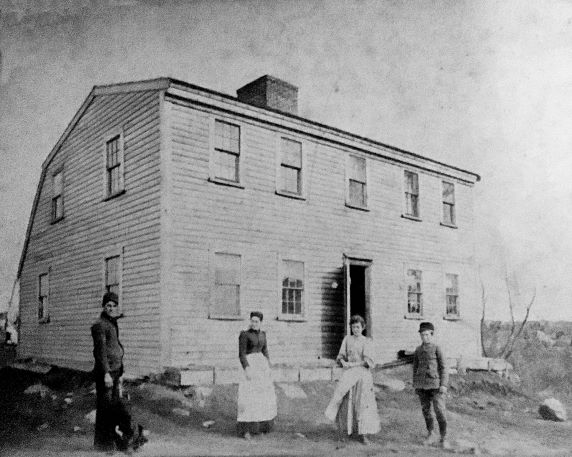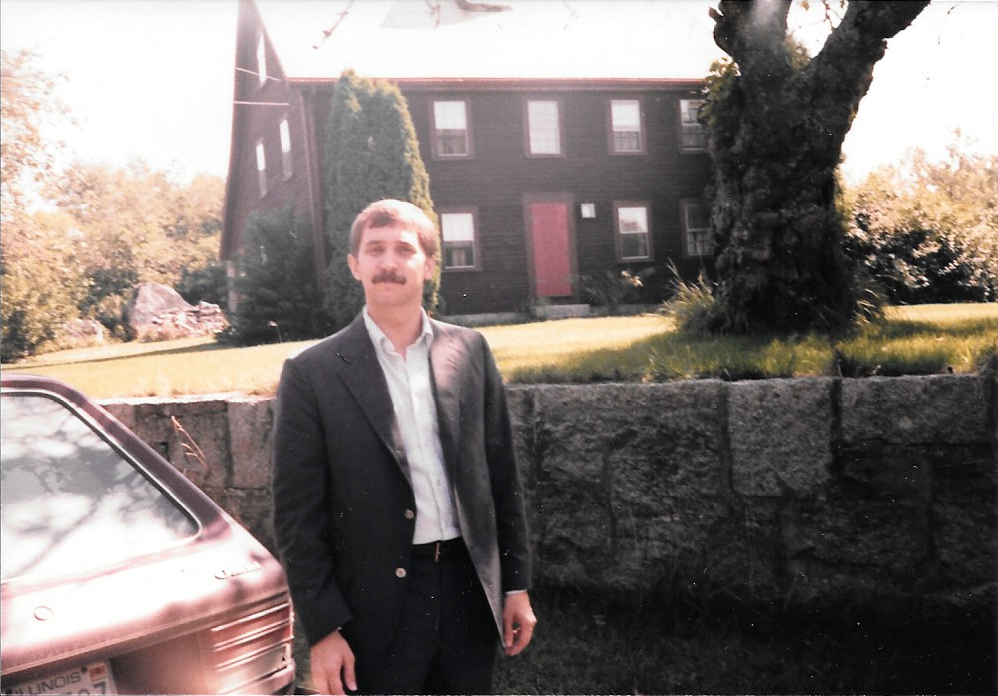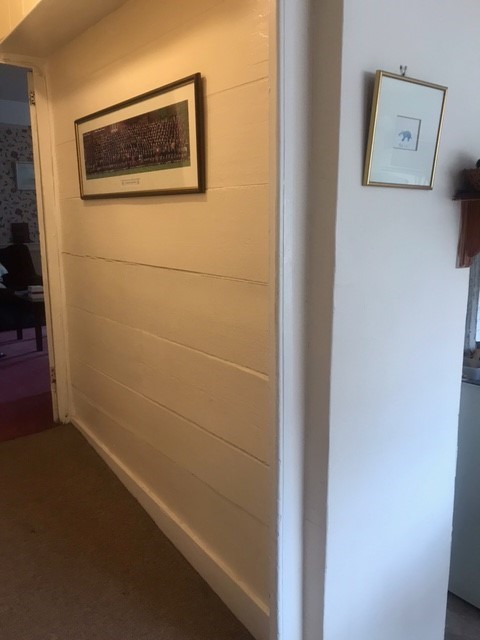Exchange of emails regarding the Friend Family Farm in Gee, Gloucester Ma.

Matt Friend <mattf9514@outlook.com> wrote: I have attached some photos of the house in Gloucester, MA on Gee Ave our family used to own. The oldest one is probably form the 1880s. In it are my 2nd great grandparents (on the left) Lemuel Friend and Mary Friend (nee Rowe). And on the right my great grandfather William Friend’s brother and sister Albert and Eva. The color photo is my dad Russ Friend in 1984 in front of the same house.

Russ wrote :- I believe my son, Matt, has a scanned photo of the Gloucester farm home my father and uncles were born in. It was built in the 1690s. After my grandfather’s accidental death in 1926, my grandmother had to move and get a job in a shoe factory. My dad and uncles were little kids (William born 1918, my dad Charles born in 1921, and Richard born in 1924). The home changed hands multiple times since then. I saw it as a kid in the early 1960s and later in 1982. It currently has more modern appearance and an addition. The farm property was taken by Gloucester and turned into a reservoir.
Will F wrote –
Thankyou Matt , for sending photos of the Friend Family farm in Gloucester , Massachusetts.
Dear Russ , that’s a sad story about your grandparents etc. . What was the name of the farmhouse ?Its nice to know its still standing . It would be nice to ‘google’ it .
Louise , George and Lizzie were driving back from Maine yesterday and found the site of the Friend Mill.
Russ Friend Wrote
I’m glad they found the mill. The home in Gloucester is at: 41 Gee Avenue, Gloucester, MA
https://goo.gl/maps/gS8RLDM1jZdzgQ8s8
The salt-box style addition was added after the 1950s by one of its many different owners. The original home now has a red front door, red cedar clapboard siding, and modern 6-over-6 pane windows. The image on Google maps was from 2013. Also, the property is completely landscaped. When I last saw it in about 1982, it was not as surrounded with so many bushes and the chimney appears to have been replaced. They used to put the year it was built on the top of the chimney.
W.F wrote
The interesting thing is how similar that farmhouse design , matches my that of my own . The New England houses used more weatherboarding – as timber was in abundant supply , whereas the in Kent and Essex , weatherboarding was mostly on the farm and fishing buildings, near the coasts, using imported Scandinavian softwoods . The other difference was that the American houses had an central brick chimney breast acting as a storage heater for the whole house , whereas Georgian houses had the chimneys on the gable ends . However the older Kentish cottages, did also have this central chimney breast . I have a 10ft square one between my older kitchen , and the later extension/rebuild . I even have a similar roadside wall along my frontage , all be it flints and brick , not granite.




Russ wrote :- Hi Will,
W F This area of East Kent was very ‘low church’ , and Charles 1st ‘s archbishop , Archbishop Laud was very ‘high’ Anglican – and particularly hated – insisting on the use of the prayer book in church services – this was a particular issue in Scotland with the Presbyterians , during this period and again in the time of James II . James I/VI was less dogmatic and reached an understanding with the scots Presbyterians and entered into a ‘covenant’ with them- they would support the crown , if they were left to worship according to their own conscience . Charles I and James II both in turn went back on this covenant with disastrous consequences !. English Congregations were all within ‘the Church of England’ and were not free to break away and clergy had to follow the services in the form dictated from Canterbury (just up the road). Some congregations met illegally in the fields to worship , although they also had to attend services in church, as well. All the various Thanet families were resolutely parliamentarian during the civil war. Larger farmers such as Francis Tomlin , had their own militia of their neighbours, family and staff . There was a divide between the enterprising/free thinking yeoman farmers, merchants, etc. – in the eastern , coastal and midlands industrial areas , and the landowners and their tenants in the West country , Wales, etc. , and in Scotland between the Protestant east Coast and Borders and the Catholic Western Isles and Highlands .
William
Dear Rusty , I have been reading up about the friend tide mill and John’ the carpenter’ friend. I thought you would be interested in an article about Simon Sackett, from the Sackett Family association , who came out at the same time with Winthrop , from the same place . They probably knew each other , and may have been related – as I am – I am as much Sackett as Friend , and the Farm here came to me from the Sackett line . My father always said that members of both families ‘signed the boston charter’ at the start of the colony . Two Richard Sacketts owned and lived at ‘East Northdown’ through the early to Mid 1700’s as well as owning ‘Sackett’s Hill’ in St Peters in Thanet, my 5 and 6 x gt grandfathers . The head of the Friend Family at Brooksend Farm . Birchington Thanet , were called John over several successive generations at the same time . I see the Wenham Friends were also called John over three successive generations – this cannot be a co-insidence !
I love the fact that so many of the family names are the same -John , Mary, William , Richard for a start !
https://sackettfamily.info/g1/p1306.htm
regards Will
Russ Friend wrote
Very interesting material. I bookmarked the Sackett Family Association site to keep it handy. One thing we know is that the colony was sparsely populated. There were perhaps four or five primary families directly related to me there in the 1630s (Friend, Rowe, Merchant, Dodge, Kimball). It would likely be that they came as “Puritans”. By the 1640s, there were at least 10,000 Puritan colonists in America. They ended up spreading out into what would become the US states of Massachusetts, Connecticut, New Hampshire, Rhode Island, and Maine. If someone wanted to have a vote and own land, they usually had to be members of the Reformed church. People were expected to be self-sufficient and industrious. That appears to run in Friend family!😉
The history of the English church had long lasting effects on America. The English Civil War brought people to the colonies, but had them split between supporting Parliament or the King (1640-1660). Those sentiments lasted well into the Colonial Civil War (American Revolution, 1775-1783). Even that resonated into the American Civil War (1861-1865) along religious lines (support for slavery and indentured servitude in central and southern states more along Catholic lines with New England abolitionists along Reformed lines). Many of the authors of our Constitution were Deists and Reformed. Because of that pluralism, the removed the concept of a state church. Nevertheless, people have chosen to support certain social issues that bring doctrines into politics.
Thanks,
Russell L. Friend, 45 Chelsea Lane. Cary, IL 60013-1910, 847-915-8660
Clearly the American political system was set up using the British system as a model , trying to improve upon it. A book you might find interesting about this period is called ‘ The Lunar Men ‘ by Jenny Uglow . It charts the lives and achievements of a group of thinkers , scientists and business people in the UK, West Midlands , ( my home area) during the later 1700’s . They met monthly on the new moon and corresponded . The group included Josiah Wedgwood, Joseph Priestly , Erasmus Darwin ,Matthew Bolton and James Watt . They were in touch with other enlightenment thinkers in Scotland , America and France , particularly Benjamin Franklin , who visited several times. It’s not an exaggeration to say their ideas formed and kick started the British industrial revolution and modern science in the fields biology, geology, chemistry etc., that took off and spread around the world. They were strongly behind the anti slavery movement. Their free thinking was a function of their protestant , questioning, beliefs, in a way that was not possible in autocratic and catholic mainland Europe. I think is an ‘essential read’ for anyone interested in such things . Regards Will
